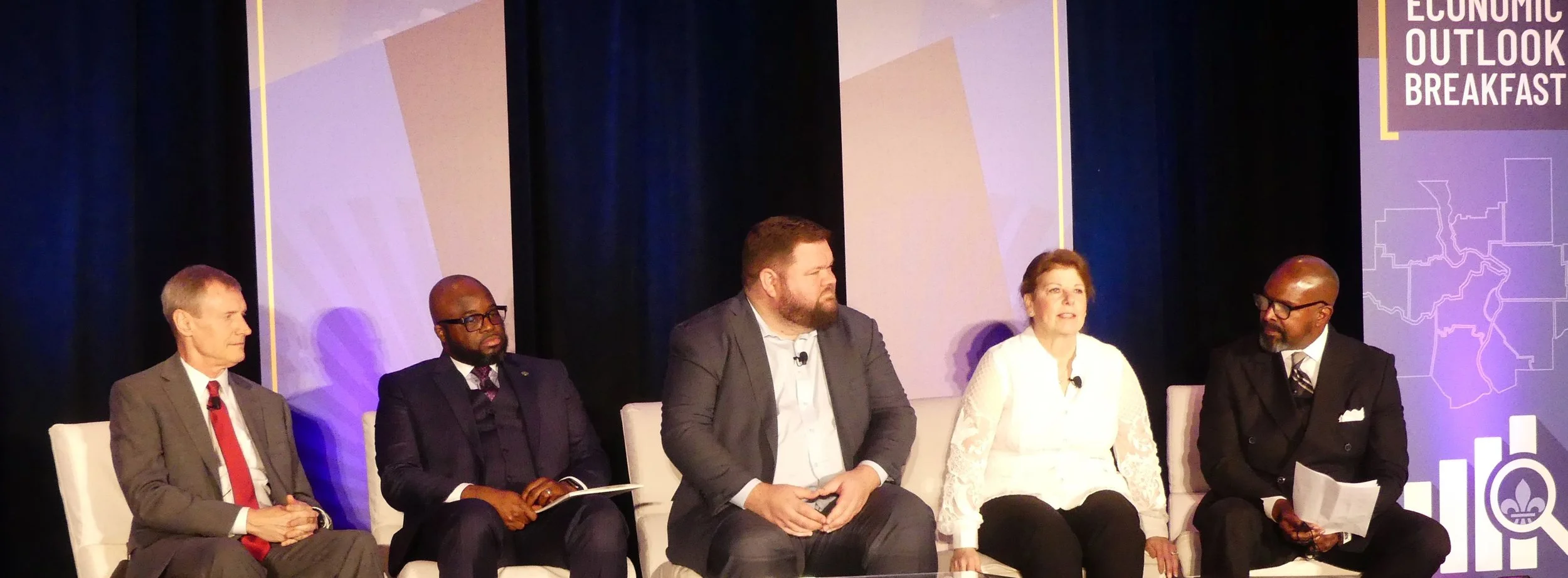St. Louis area Chambers of Commerce partnered with Greater St. Louis, Inc. to bring 600 colleagues together on November 9 at the Renaissance St. Louis Airport Hotel for a first-ever Economic Outlook Breakfast focusing on how the region’s large and small businesses can work together more effectively to improve opportunities for growth and success, including in commercial real estate ventures.
MC and panel moderator Rene Knott, co-anchor of DKSD-TV’s “Today in St. Louis,” opened the event by saying that the success of small businesses “is why we are here — the little guy is the foundation of our community.”
Jason Hall, CEO of Greater St. Louis, Inc. welcomed attendees with thanks to STL County Executive Sam Page and several mayors, the 21 area Chambers represented in the audience, and investors who are key to the business sector.
“Greater St. Louis, Inc. is proof positive that we have what it takes to up our game … and (can) start competing again with other cities around the globe for jobs and people,” Hall declared. “St. Louis is resurgent … because of the way we choose to compete: We compete as one.”
He named Boeing, American Food Groups, Advantage Corp. headquarters, NASCAR Cup series, Bungee Corp and Lufthansa as recent successes in attracting new business to the St. Louis area, all of which present opportunities for commercial real estate projects.
The key to those and future business expansions is that “when we compete differently when we compete collaboratively, we win.”
Hall echoed Knott’s perspective, noting that recent area-wide growth is “not just (about a) focus on large businesses; we have to include small businesses. We are showing up in all 15 communities (around STL).”
Hall also mentioned the Wayfair Fix, which has made doing business easier by closing a tax loophole.
“We heard loud and clear that we need to support buying local,” he said. “We’re going to light up our region.”
Featured speaker Stefani Pashman, CEO of the Alleghany Conference on Community Development, provided an overview of the nearly 80-year-old public-private partnership’s focus on economic growth and quality of life for the 10 counties of southwest Pennsylvania (Pittsburgh metro area). She drew on similarities between the formerly disconnected, competitive approach to her area and the overall St. Louis region as an example of how disparate groups can come together to strengthen and cooperate on economic growth.
“We began the redevelopment process 30 years ago,” Pashman said. “We both have similar industries. Fragmentation was one reason we came together. We had 200 economic development groups and no cohesive plan. We formed (a regional association) to find a way to win together and advocate for the entire region.”
Their success, she said, proves that “regionalism works, regionalism matters, regionalism is the only way. You can never, ever take it for granted.”
A panel of regional business and development leaders presented perspectives on what the STL region has and needs to prosper as a whole: Joan Daleo, president and CEO, Ole Tyme Produce; Samuel Murphey, chief strategy officer, Greater St. Louis, Inc.; Arrey Obenson, president and CEO, International Institute of St. Louis; and Tim Schoenecker, Ph.D., dean emeritus, School of Business, Southern Illinois University Edwardsville.
Daleo provided an example of a long-time successful family-owned business that managed to survive the pandemic and is thriving again, with a major anniversary this year.
Obenson described how his organization helps immigrants to St. Louis overcome challenges and barriers — language, the financial system, traumatic experiences — and the impressive successes they have seen in adapting to their new home. “We position St. Louis as welcoming.”
Murphey described the STL 2030 jobs plan that rolled out at the same time Greater STL began to “drive inclusive economic development” and create a framework to measure population growth, median household income, homeownership and reducing the Black-white gap. “We are starting to see a bounce back from the pandemic,” he noted.
Schoenecker emphasized the role of small businesses in the regional and national economy: 90 percent of the 30 million or businesses in the U.S. are small businesses, employ half of the workforce and are more efficient and likely to be innovative than large ones, and most large corporations started out as small or entrepreneurial ones.
He added that area education institutions are seeing a growing interest among students in entrepreneurship and business, as well as a lot of startups in the region. “That role will only grow over time.”
Panelists agreed that downtown is vital to regional business growth. “We will have to make some changes: Some office buildings will have to transition (to other uses). Public safety is a challenge.”
Daleo echoed the perspective on collaboration throughout the region as one of the lessons of the pandemic: “If you aren’t working together, you’re in combat mode. You’re stealing (business, employees, etc.) from each other. When we work together, we all grow.”
In essence, panelists agreed with Schoenecker that “St. Louis’s best days are not behind us.”
“We have a utopia vision for St. Louis. We see the region with a thriving, inclusive economy. We’re getting the fundamentals right,” said Murphey.
As Knott concluded, “It ain’t over yet! We got this. People are realizing the real that is St. Louis and are coming back. It is a growing place. It’s time to get on board and ride with us.”

